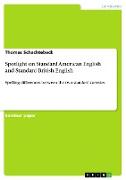Spotlight on Standard American English and Standard British English
BücherAngebote / Angebote:
Seminar paper from the year 2007 in the subject English - Grammar, Style, Working Technique, grade: 1, 3, Free University of Berlin (Fachbereich Englisch), course: Sociolinguistics and Varieties of English II , language: English, abstract: Throughout the 20th century, Standard British English (hereafter BrE) and Standard American English (hereafter AmE) made up the two 'reference varieties' of the English language. Even today - in the 21st century - BrE and AmE represent "a large proportion of all native speakers of English (83 per cent)" [Svartvik & Leech 2006: 150] in the world. The reason why these two varieties have aquired such a prestigious position among many other varieties of English is that in Great Britain and in the United States - two of the most influential nations of the 20th century in terms of political power and economical strength - "English has been institutionalised longer than anywhere else" [Cheshire 1991: 13]. Consequently, BrE and AmE "provided the chief native-speaker models which non-native speaking teachers of English" [Svartvik & Leech 2006: 150] aim to instil.
Although both 'reference varieties' of English seem to be very much the same at first sight, "British and American English undoubtedly are different, and Englishmen and Americans undoubtedly know it." [Partridge & Clark 1951: 308]. Closer investigations reveal that AmE is different from BrE at levels of phonetics, phonology, grammar, lexis and spelling. Whereas the fields of pronunciation and lexis definitely share the most prominent and numerous differences between AmE and BrE, the field of spelling shows only a couple of minor differences. Today, the vast majority of English lexis is spelled the same in AmE and BrE. However - to a certain extent - there are some characteristic spelling differences between AmE and BrE which many learners of English are not well familiar with.
In the following, this paper concentrates on pointing out the major differences in spelling between contemporary AmE and BrE since this linguistic field of interest is very strongly related to the different historical and political developments America and Great Britain went through. Therefore, this paper will first work out some historical reasons for the development of spelling differences between the two 'reference varieties' and highlight America's most influential attempts to standardise American spelling. Afterwards, it will give a detailed overview about the most prominent and common spelling differences between AmE and BrE by categorising them into three major groups and providing a couple of examples for each group, and finally, this paper will briefly reflect on the situation of AmE and BrE in the world today.
Folgt in ca. 10 Arbeitstagen




